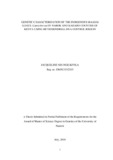| dc.contributor.author | Kivila, Jacqueline Ndunge | |
| dc.date.accessioned | 2018-10-22T06:28:52Z | |
| dc.date.available | 2018-10-22T06:28:52Z | |
| dc.date.issued | 2018 | |
| dc.identifier.citation | Master of Science Degree in Genetics of the University of Nairobi | en_US |
| dc.identifier.uri | http://hdl.handle.net/11295/104302 | |
| dc.description.abstract | The Kenyan indigenous Maasai goats (Capra hircus) have been
very scantily characterized, which has resulted in poor efforts to fully
exploit and conserve these genetic resources. Genetic characterization is
necessary because it would be a guide in prioritizing the efforts of
conservation and production. It will also help in developing genomic tools
to be used in selective breeding programs. This study aimed at
characterizing and comparing the gene pools of the indigenous Maasai
goats in Narok and Kajiado counties using the mitochondrial DNA
(MtDNA) control region. Fifty goat blood samples were obtained from
both counties (25 from each county) but only thirty samples were used in
the analysis; fifteen from each county. Extraction of DNA from whole
blood was done using the standard phenol: chloroform method and
amplified successfully to the expected size of 880 base pairs.
Phylogenetic and haplogroup analysis using 22 MtDNA reference
sequences showed that these goats clustered into two haplogroups A and
G. Haplogroup A was the most common and internally varied as
compared to haplogroup G. Seventy four (74) polymorphic sites and 26
haplotypes were determined in an 880-bp sequence. This study also
found a very high haplotype diversity of 0.989 + 0.013 and a low
nucleotide diversity of 0.02252 + 0.0016 between these two indigenous
goat populations. There were no fixed differences between the two
populations. Genetic diversity showed a slightly positive Tajima’s D
value (0.231463) which may indicate that the population may have
undergone a recent bottleneck or there is over-dominant selection of a
trait that is linked to the analysed locus. A Chi-square analysis of genetic
differentiation gave a p-value of 0.4236 (df:37) which was statistically
non-significant at p<0.05, indicating a lack of statistical difference
between the two populations. This is an indication that a strong gene flow
exists between the goat populations in Narok and Kajiado counties and
may further suggest that the two populations share a single gene pool.
This study shows the presence of high genetic diversity and variation
within the two goat populations. It also shows that there is positive
selection of a trait that is linked to the mitochondrial DNA control region.
These results can serve as an initial step to plan for the conservation of
indigenous Maasai goats in Narok and Kajiado counties. However, further
research should be carried out using other molecular markers and also
including indigenous goat populations from other counties in Kenya. | en_US |
| dc.language.iso | en | en_US |
| dc.publisher | University of Nairobi | en_US |
| dc.rights | Attribution-NonCommercial-NoDerivs 3.0 United States | * |
| dc.rights.uri | http://creativecommons.org/licenses/by-nc-nd/3.0/us/ | * |
| dc.title | Genetic characterization of the indigenous Maasai goats (capra hircus) in Narok and Kajiado counties of Kenya using mitochondrial DNA control region | en_US |
| dc.type | Thesis | en_US |



